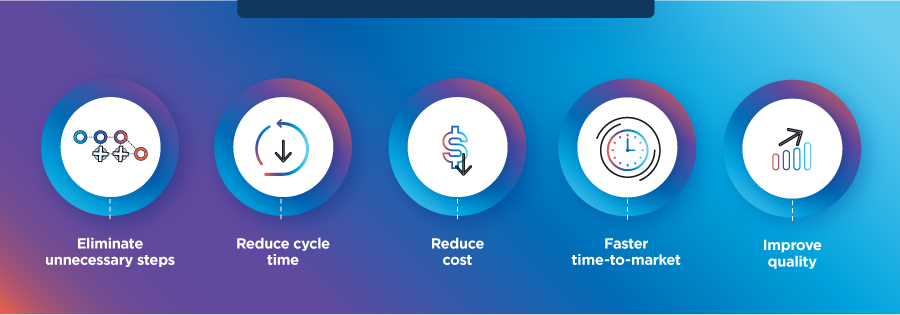Business Process Reengineering

Business process reengineering (BPR) is about taking your existing business processes and completely reimagining and reworking them to make them better.
There’s no point in reinventing the wheel, but if we stopped when we first invented it, we’d still be driving a three-wheeled automobile. Over the years, car manufacturers have taken small steps to improve motor vehicles. But huge changes – like we’ve seen with electric cars – took more than just a few tweaks. Those took a reinvention of the base model, and now look where they are.
That’s how you can view BPR implementation: It’s taking a seismic shift in an organization’s way of thinking and doing by restructuring its core business processes. BPR is a significant reengineering effort, so let’s look at the tools and steps required to do it successfully.
What Is Business Process Re-Engineering (BPR)?
Founded by Michael Hammer, BPR began as a management strategy theory to help businesses struggling to make profits in a competitive market. BPR helped them create redesigned processes by making significant improvements and rethinking how they fundamentally get work done – things like quality, cost, services, customer satisfaction, time to market, output and efficiency – to make them more competitive.
Is business process re-engineering (BPR) the same as business process improvement?
BPR is a strategy for radically restructuring a business, focused on the ground-up design of its business processes. It’s a big, dramatic change.
Meanwhile, business process improvement (BPI) is the process of continuous improvement of business operations by making small tweaks here and there. BPI includes identifying, analyzing and optimizing process performance so you can improve its efficacy over time, whereas BPR is all about huge shifts in an organization’s approach to work.
The goals of BPR and BPI are similar: Ensuring everything runs at peak levels for customers, employees and the business through improved processes. But BPR is a much larger undertaking, requiring a complete rethinking of your process framework with the goal of business process optimization (BPO).
Why would I need Business Process Re-Engineering (BPR)?

A complete redefining of your business processes may be necessary – and we’d advise you to first go through the work of performing a thorough business process analysis, mapping and modeling of your existing processes before making that decision – to get your organization ready for intelligent automation (IA).
The benefits of BPR can include:
- Eliminating unnecessary steps
- Increasing analytical insight
- Reducing cycle time
- Improving overall efficiency
- Maximizing value for customers
- Reducing costs
- Increasing productivity
- Improving quality
- Achieving faster time-to-market
- Delivering better customer satisfaction
How can BPM help with Business Process Re-Engineering (BPR)?
Business process management (BPM) is a business process orchestration tool that brings your workforce together in a cohesive, streamlined environment and helps you organize and structure your processes. BPM’s cross-functionality will be a crucial tool when you’re radically redesigning entire business processes to ensure nothing falls through the cracks.
The benefits of BPM offer better visibility into your business, predicted outcomes, optimized and standardized processes, and an easy way to continuously improve processes. The BPM lifecycle covers a cyclical approach to improving business processes through discovering, analyzing, designing, implementing and improving. SS&C | Blue Prism® Chorus BPM allows organizations to rapidly build and automate processes, optimize workflows and create digital customer experiences.
Intelligent automation (IA) combines robotic process automation (RPA) and BPM with artificial intelligence (AI) to create more optimized business processes. IA can also be referred to as business process automation or digital process automation.
Better BPM reduces the need for BPR
Weigh the cost, time and benefits of reengineering your processes and what supportive measures you can take. With BPM, you can manage changes more easily and also save costs on analysis, reengineering and even documentation.
SS&C Blue Prism’s intelligent automation platform, which includes BPM, allows your business users to create and deploy automated processes with no coding required. You can create new processes or improve existing ones using our low-code, drag-and-drop development tool – with all the visibility and managed organization of our BPM software.
How Is Business Process Reengineering Implemented?

As we said, BPR is a radical shift, so you’ll want to stay organized with BPM and make sure you’re making changes in the right places. Transparency and understanding are key to a successful BPR. That said, let’s look at the five critical steps involved.
5 steps of business process reengineering
- Map your as-is processes: Use process modeling and mapping tools like process mining, task mining and BPM to help you understand how your processes are currently performing.
- Identify inefficiencies and bottlenecks: Note any errors or slowdowns in your workflow and gather all the details and steps within the process that will need adjustment.
- Find and validate opportunities for improvement: Process mapping tools can also help you find opportunities for optimization and where you can implement automation. They can identify unnecessary steps that you can remove to reduce process complexity, which will then make the process easier to automate.
- Design an optimal process map: Now that you know how your processes could run, you can completely redesign them and develop an optimal process map. Set and keep metrics of business process reengineering (BPR) so you can see the changes in your process performance over time.
- Set yourself up for the future: Ensure all team members in your organization are aware of the changes before implementing them, and only proceed once everyone’s on board and educated on how the new process will work.
A bonus sixth step – and potentially the most important – is to continuously monitor and improve as you go. When your organization undergoes a change as drastic as BPR, it’s essential to stay agile and innovative. Don’t let this one reimagining become your stopping point.
What Are Examples of Business Process Reengineering?

Remember how we talked about cars earlier? Well, one well-recorded example of early BPR was successfully implemented by Ford Motors. In the 1990s, they reengineered their processes and dramatically cut expenses – helping them become the competitive car manufacturer we all know today.
BPR use cases and examples
Consider some examples of where BPR might help your organization achieve significant improvements:
- Supply chain optimization: Reengineering supply chain processes could streamline inventory management, reduce lead times and improve supplier relationships by removing communication friction.
- Customer relationship management (CRM): Rethinking customer interaction processes could help you provide better service and support. It might involve integrating customer data across departments, implementing a unified CRM system or redesigning customer service workflows to resolve issues more efficiently.
- Financial management: Redesigning financial processes such as budgeting, invoicing and expense management could reduce costs and errors and improve the accuracy of your financial reporting. Automating repetitive tasks with IA could play a huge role in this.
- Manufacturing processes: Overhauling production processes could help improve productivity and product quality and reduce waste. It could involve adapting lean manufacturing principles or automating error-prone, tedious tasks such as data entry and inventory management.
- Human resources management: Transforming HR processes like recruiting, onboarding and training can help with employee satisfaction and retention. This might involve digitizing paper-based processes, implementing self-service portals or using BPM data analytics to better understand and plan your workforce.
- Marketing and sales: Reengineering marketing and sales processes could help you better identify and target qualified customers to personalize offerings and optimize conversion. This might involve a new marketing automation platform or segmenting customer groups with data analytics.
Should I Consider BPR?
BPR is a big step – and a massive undertaking. For larger organizations, a change like this is going to be expensive based on the sheer volume of processes and people involved. But when the marketplace shifts, your organization needs to be agile to stay competitive. It may be time to rethink your core business processes and imagine a total restructuring.
Here are some of the questions you should ask before implementing BPR:
- Are my costs and cycle times too high?
- Am I losing productivity?
- Are there too many management layers in my organization?
- Are there too many errors, rework and handoffs?
- Does our quality/standardization need to be improved?
- Do our current processes mesh with our long-term missions and goals?
- Is our current way of working delivering enough value to the organization?
- If we completely redesigned our organization, would it be worth the cost, time and effort?
- Do I have sufficient and accurate data to answer all of the questions above?
Start your total organizational reengineering with business process management. Read our BPM e-book to discover more about how it works and how it can benefit you.
